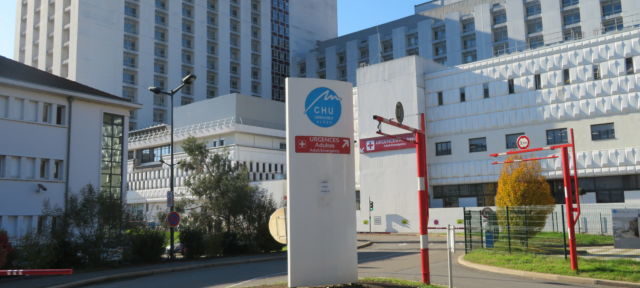FOCUS – Since 1st January 2016, the city of Grenoble, along with forty-two of the city districts, are experimenting with a speed limit of 30 km/h. Only a few major roads will retain the limitation at 50 km/h, as an exceptional measure. This is the first major experiment on this scale, with the authorities expecting to see beneficial effects, both economically, and in safety and pollution levels.

© Joël Kermabon – Place Gre’net
The generalization of circulation at 30 km/h came into force, in 80% of the streets of Grenoble, on 1st January, 2016. However, Tuesday 5th January was chosen, to unveil a 30 km/h speed limit sign at the entrance of Catane – a compulsory communication – in front of a high media turnout..
Just a few steps away, another sign announces to motorists that they now entering “a peaceful city”.
One way, perhaps, to defuse any criticism of a measure that has already caused a stir in the Grenoble Landernau since its announcement.
An average speed of between 17 and 18 km/h in the city
A more peaceful city ! At least, this is the wish expressed by forty-three out of the forty-nine city districts, on the initiative of the new regulations. Mont-Saint-Martin, Sarcenas, Quaix, Meylan, Saint-Paul-de-Varces and Notre-Dame-de-Mésage did not want to adopt the new measures.
A collective decision, which Éric Piolle, mayor of Grenoble, echoes. “This is an initiative that has no political colour”, he points out, not without satisfaction. The elected official is convinced that “it’s all about adapting our cities into public areas, where the public can move around in a calmer manner”.

From left to right : Jacques Wiart, Mondane Jactat et Philippe Zanola. © Joël Kermabon – Place Gre’net
What this will change for the people who live in the city ? Firstly, it is the reversal of a rule : 30 km/h will be the norm on most roads, while the speed of 50 km/h will be the exception.
However, this should not change much, at least in the city centre. “Today, in the town centre, the average speed is between 17 and 18 km/h”, adds Jacques Wiart, delegated council official for travel and urban logistics.
Secondly, about thirty fixed or mobile radars will be installed. The objective ? To remind road users of the new rules and to accompany the change. “We want a real behavioural change in our relationship with the city and traffic, and much more attention to be paid to pedestrians and cyclists”, explained the official.
“A very good economic opportunity for the municipality”
The announcement of the new restrictions, some months ago, provoked an outcry from the traders, saying it would discourage potential customers from visiting the city centre. Opposition was quickly swept under the carpet by Jaques Wiart. “We are convinced that, on the contrary, it is a great economic opportunity for the town. Thus, we will revive trade and economic activities in the city. With the city limited at 30 km/h there will be more fluidity”, retorted the elected representative.
According to him, it’s a much sought after fluidity, by logistics professionals, which should not penalize deliveries, as predicted by many traders. Quite the contrary !
To conclude the chapter, Éric Piolle evokes that, in his opinion, recurring recriminations could be appropriately resolved by the optimal use of park and ride.
“The fears of traders, are the same as when they were when they protested against pedestrian areas, explains the mayor of Grenoble […] We have more than a thousand empty parking spaces, even at peak business times, whether in existing car parks or those under construction. There is, therefore, a real possibility to absorb cars and, thus, ensure that the public areas can come back to life again and facilitate trade.”
Reduce noise and pollution levels
Mondane Jactat, municipal council delegate for health and prevention, assures that the speed limitation measures will improve the safety of the public, and reduce noise and pollution. “It is the safety of the most vulnerable on the street, which is in question. At 30 km/h, the braking distance will be divided in half, from 27 to 13 metres, which will divide the risk of death by nine”, ensures the representative.

At the left, Mondane Jactat. © Joël Kermabon – Place Gre’net
As for noise, which is, according to the councillor, the main nuisance felt by the population, it will decrease sharply. As a side effect, it will be the same for pollution ; a major challenge in improving the health of the population, living on the effected roads.
The “safety” aspects of the measures, while important, are not the most emblematic.
That, at least, is the view of Philippe Zanola, member of the Association for the development of public transport, cycle lanes and pedestrian areas in Grenoble (ADTC) and the association for streets in the future. “The city will finally become a real city […]. We have managed to create networks of roads in our towns, with drivers isolated in their own environment”, he says.
To continue : “It is very important to rediscover this urban space, to win it back, and we hope the next step will be a better sharing of this public space, which is currently 80 to 90% attributed to the automobile”, concludes the associative activist.

© Joël Kermabon – Place Gre’net.
What about control ? On this point, Éric Piolle is reassuring. Admittedly, this is a change in the regulations, but it is not a question of trapping motorists.
“We’ll progress slowly. Signs and road markings will be changed gradually, and the radars will be placed mainly for training purposes. Everything will be done to facilitate the transition, this change in practice”, said the mayor.
N.B.: In addition, monitoring and evaluation will be implemented. The objective ? More flexibility and scalability in the implementation of the measures.
Joël Kermabon
Traduction from Speak English Center
Phone : +33 4 76 50 39 79
1 avenue du Vercors, 38600 Fontaine FRANCE
















